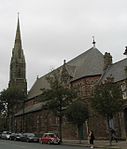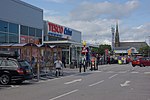Custom House, Barrow-in-Furness
Barrow-in-Furness port and shipyardBuildings and structures in Barrow-in-FurnessCustom houses in the United KingdomGovernment buildings completed in 1870Grade II listed buildings in Cumbria ... and 2 more
Tourist attractions in Barrow-in-FurnessUse British English from November 2017

The Custom House in Barrow-in-Furness, Cumbria, England is a former government building, having housed the customs offices for trade handled at the Ports of Barrow and Lancaster. Initially constructed as a hotel around 1870, it took on its most notable role as a custom house in 1880, regulating custom from the Port of Lancaster.The four-storey Italianate style building stands on the corner of Abbey Road and Hindpool Road. The Custom House was granted Grade II listed building status in 1976 when it was a social club. It has since been converted to contain a number of restaurants and leisure facilities, including LazerZone
Excerpt from the Wikipedia article Custom House, Barrow-in-Furness (License: CC BY-SA 3.0, Authors, Images).Custom House, Barrow-in-Furness
Hindpool Road,
Geographical coordinates (GPS) Address Nearby Places Show on map
Geographical coordinates (GPS)
| Latitude | Longitude |
|---|---|
| N 54.1128 ° | E -3.2331 ° |
Address
Speed of Sound Car Audio
Hindpool Road
LA14 2NB , Hindpool
England, United Kingdom
Open on Google Maps











